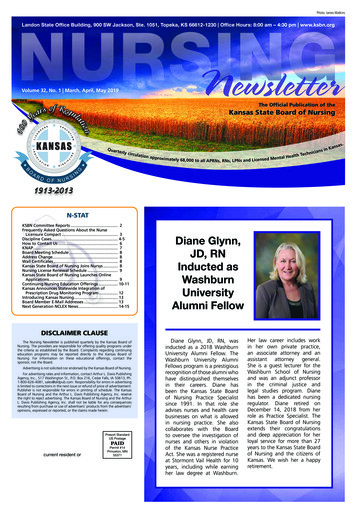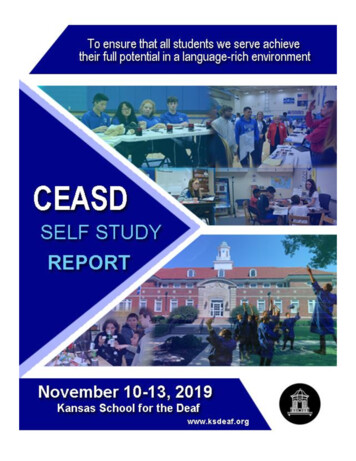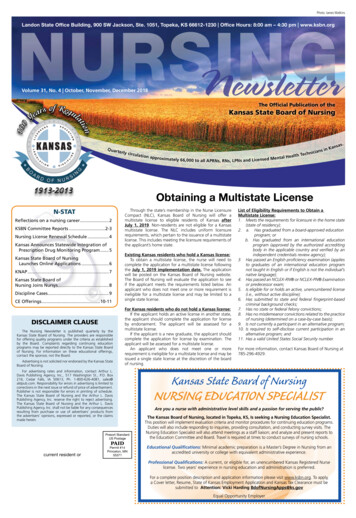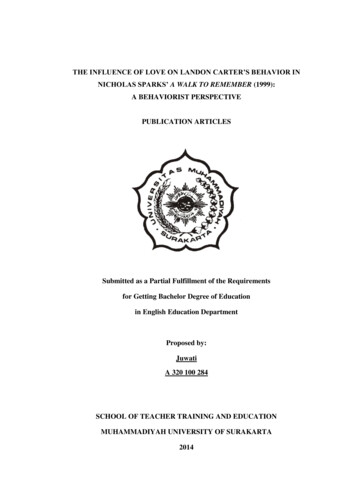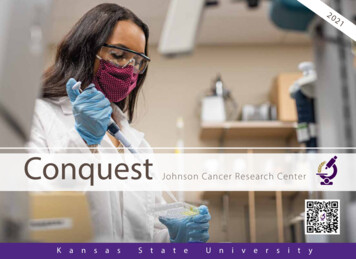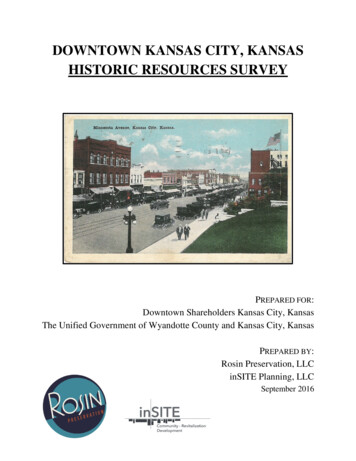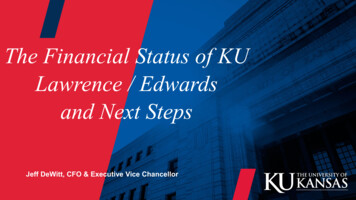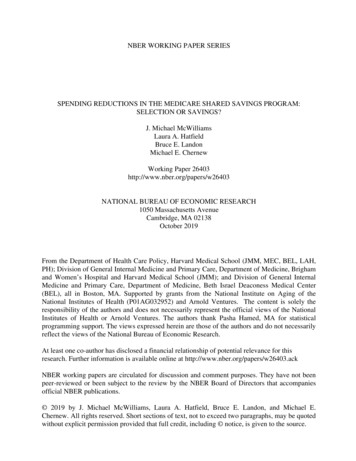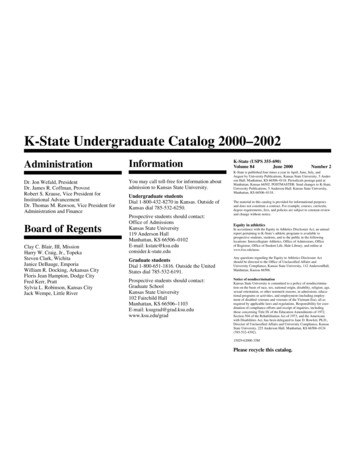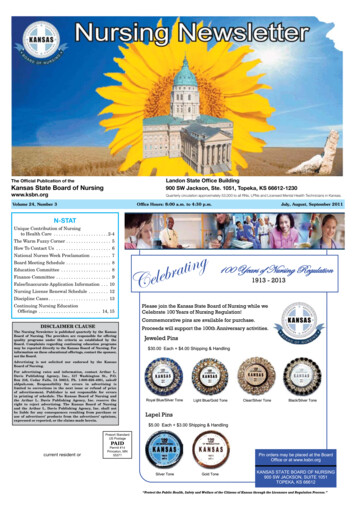
Transcription
Landon State Office Building900 SW Jackson, Ste. 1051, Topeka, KS 66612-1230The Official Publication of theKansas State Board of Nursingwww.ksbn.orgQuarterly circulation approximately 53,000 to all RNs, LPNs and Licensed Mental Health Technicians in Kansas.Volume 24, Number 3Office Hours: 8:00 a.m. to 4:30 p.m.N-STATUnique Contribution of Nursingto Health Care . . . . . . . . . . . . . . . . . . . . . . 2-4The Warm Fuzzy Corner. . . . . . . . . . . . . . . . . . . 5How To Contact Us . . . . . . . . . . . . . . . . . . . . . . . 6National Nurses Week Proclamation . . . . . . . . . 7Board Meeting Schedule. . . . . . . . . . . . . . . . . . . 8Education Committee . . . . . . . . . . . . . . . . . . . . . 8Finance Committee . . . . . . . . . . . . . . . . . . . . . . . 9False/Inaccurate Application Information . . . . 10Nursing License Renewal Schedule . . . . . . . . . 12Discipline Cases. . . . . . . . . . . . . . . . . . . . . . . . . 13Continuing Nursing EducationOfferings . . . . . . . . . . . . . . . . . . . . . . . . . . 14, 15DISCLAIMER CLAUSEThe Nursing Newsletter is published quarterly by the KansasBoard of Nursing. The providers are responsible for offeringquality programs under the criteria as established by theBoard. Complaints regarding continuing education programsmay be reported directly to the Kansas Board of Nursing. Forinformation on these educational offerings, contact the sponsor,not the Board.Advertising is not solicited nor endorsed by the KansasBoard of Nursing.For advertising rates and information, contact Arthur L.Davis Publishing Agency, Inc., 517 Washington St., P.O.Box 216, Cedar Falls, IA 50613, Ph. 1-800-626-4081, sales@aldpub.com. Responsibility for errors in advertising islimited to corrections in the next issue or refund of priceof advertisement. Publisher is not responsible for errorsin printing of schedule. The Kansas Board of Nursing andthe Arthur L. Davis Publishing Agency, Inc. reserve theright to reject advertising. The Kansas Board of Nursingand the Arthur L. Davis Publishing Agency, Inc. shall notbe liable for any consequences resulting from purchase oruse of advertisers’ products from the advertisers’ opinions,expressed or reported, or the claims made herein.Presort StandardUS PostagePAIDcurrent resident orPermit #14Princeton, MN55371July, August, September 2011
Page 2 Kansas Nursing NewsletterJuly, August, September 2011Unique Contribution of Nursing to Health CareCheryl L. ThompsonHutchinson Community CollegeDebbie Gieselman, MSEd, Counselor, HCCPN Program & McPherson Center; DebraHackler, MSN, RN, Department Chair; Cheryl L.Thompson; Mary Blubaugh, Executive Director,KSBN; and Janet Jacobs, LPN, Board VicePresidentIntroductionWhere do you begin when outlining thecontributions of nursing to health care? Is it thecapability of performing more than one task at atime or is it one's unique possession of compassionand dedication? Are nurses developed or bornwith a God-given talent to care, listen, and heal?Could anything be more complex than the healthpractices passed down through the passages oftime? From rituals and potions, to disinfectionand immunization, the one commonality throughhistory is the practice to rid the body of the illsthat cause suffering and death. In the midst ofthat behavior, is the concept and contribution ofthe nursing profession.In the BeginningNursing has always been prevalent; startingback in the prehistoric period when practices wereguided by beliefs of magic and superstition, to theperiod of early civilization that gave us suturing,surgeries, and practices from distant cultures.During the Middle Ages, women healed withherbs, carried food and medicine from house tohouse, and female nurses were forbidden to carefor male patients. Then came the Renaissanceand Reformation periods which birthed majoradvancements in pharmacology, chemistry andanatomy, not to mention the development oftraining for nurses, education programs, and carefor the abandoned out of concern for the socialwelfare of the sick and poor. Last, but not least,the Colonial American period gave us hospitalsand medical schools during a time when infections,plagues, and diseases shortened the life span ofthousands.Now consider the courage, intelligence, and skillof Florence Nightingale. She led a band of nursesinto war to care for casualties with little supportand even fewer supplies; yet she persevered andinitiated principles of asepsis, infection control, andrehabilitation that paved the road to the healthcare reforms and sanitary conditions that existtoday. She was the heroine of patient advocacyand was only one of the many advocates throughtime that demonstrated the stamina and sacrificerequired to deliver quality and competent nursing.The discipline of nursing has evolved throughtime, yet the fundamentals of nursing have notchanged. The role of nursing still focuses on thevalues, the knowledge, and the skills needed tocare for the ill and meet the needs of the public.Today's nurse is logical, educated, and empoweredto perform in a capacity whose sole purpose is toenhance the quality of life, honor the patient'sright to choose, and support the functional basis ofnursing practice in an ever changing health careenvironment.At the core of the unique role of the nurseare two accountabilities: the ability to meet thepatient's needs and the ability to understand thehuman health experience through the patient'seyes. There is no greater dimension the nursingprofessional can engage in than reinforcing thepatient understands that someone knows and reallycares about them alone. It is an opportunity and achallenge that measures the drive, motivation, andinner integrity of the individual encompassing therole of the licensed or registered nurse.SummaryA blend of values, intellect, skills, andcompassion is the "unique contribution of nursingto health care." A profession that has evolvedthrough the ages based on the organization,planning, education, and training required todevelop that unique breed of care giver. The nurseis an individual whose actions influence a patient'scare and recovery; whose perception responds tothe needs of not only the patient, but the family aswell; and whose role and commitment of deliveringquality care must never be compromised.How grave it is to acknowledge the fact thatthis country and the global communities face ashortage of nurses; even though nursing is still thelargest health care profession on the planet. Nursesdetermine the future of health care throughout theworld and they will continue to learn, manage andmaintain the highest of ethical standards becausethat is their "unique contribution to health care."I now embrace a career in nursing whosefoundation has never waivered in the role ofdiscipline for hundreds of years. It is an honorand an extraordinary experience to become anurse. Technology and teaching has advanced,equipment and simulators are state of art, anddisease and drug references are no further thanyour fingertips. Nursing will be the hardest job Iwill ever love and the greatest accomplishmentI will ever achieve. The time has come to makemy "unique contribution to nursing" and I willapproach it physically, mentally, and with totality.Danielle SimmonsLPN Winner, Wichita Area Technical CollegeMary Blubaugh, Executive Administrator, KSBN;Danielle Simmons, LPN Winner; and JanetJacobs, LPN, Board Vice PresidentNursing has made thousands of commendablecontributions to health care throughout history. Overtime, many of those contributions evolve because oftechnology. One unique contribution of nursing tohealth care that has been saved from the evolutionof technology is compassion. Florence Nightingale setthe standards high in the compassion department forall future nurses to follow.Compassion is defined as a virtue, one in whichthe emotional capacities of empathy and sympathyfor the suffering of others are regarded as a part oflove itself, and a cornerstone of greater social interconnectedness and humanism. This definition setthe sky as the limit, when applied as the uniquecontribution of nursing to health care. Surroundingtheir patient with compassion is one of a nurse’sassigned tasks for day. There are many patients’that will never have a family member walk throughthe door with a get-well balloon, flowers or card.Therefore the nurse’s compassion becomes those getwell presents and it has the opportunity to alleviatesome of their suffering.A word’s definition can be clarified for manyby looking at synonyms for that particular word.Synonyms for compassion or compassionate aresympathy, empathy, concern, kindness, consideration,care, concerned, gentle, kind hearted, caring, andbenevolent. All of these colorful words draw a pictureof nursing’s contribution to health care.Majority of American citizen’s will interact witha nurse at some point in their lifetime. This gives anurse an opportunity to contribute compassion to thehuman race. A nurse takes on a special role as he orshe walks into work every morning. Facilitating withcoping takes a unique individual to be compassionate.At times a nurse has to forsake their own desires andbe compassionate to a patient. Although a patientmay be resistant to confiding in a physician, familymember, or loved one, after rapport is developedbetween with a nurse and the patient, many patientswill open up to a compassionate nurse. Nurses havethe power in their hands to contribute compassion atlib without the physician’s order.Florence’s beliefs were the foundation of hercurriculum to start the first Nightingale trainingschool for nurses. One of her goals stated thefollowing; Nurses should help identify and meetpatient’s personal needs, including providingemotional support. Not only will patients be touchedby a nurse physically, but a nurse can touch aperson’s heart forever by the unique contributionof compassion. Florence Nightingale’s influencecontinues in the profession of nursing because of hercompassion for the human race.
July, August, September 2011Kansas Nursing Newsletter Page 3Unique Contribution of Nursing to Health CareEllen ThomasBSN Program, University of KansasMary Blubaugh, Executive Administrator, KSBN;Ellen Thomas; and Janet Jacobs, LPN, BoardVice PresidentImagine a busy emergency department. Clients areintolerantly waiting to be seen. Physicians are busy inrooms with those lucky clients who finally are calledback. An ambulance arrives bringing in a clientwho was in a severe car accident. The physiciansdrop everything to work on this client. The family ofthe client comes in, scared and confused. They keeptrying to go in and see their relative and get theirquestions answered. Will their son live? Will my fatherbe paralyzed? they ask. Meanwhile, the other clientsin the waiting room are growing more and moreimpatient, because they have not been seen yet. Thisscene is incredibly chaotic because one essential factoris missing—nurses. While nurses cannot instantlymake busy emergency departments a peaceful place,they can bridge healthcare to the client. They cantalk to the family and try to reassure them. Theycan help move clients though triage. Nurses have thecritical role in healthcare as the clients' advocate andthe connection between medicine and the client.Without nurses, health care would be a confusing,scary place. As nurses, we stand up for our clients'rights. We make sure that our clients are not lostamong the charts and jargon and diagnostic testing.Nurses remind medicine that there is a face and astory behind every diagnosis. If a client has a beliefor tradition that is important to them, the nursemakes sure this is respected during their care. Ifthe client is having a bad day, the nurse is the firstof the health care team to know it. Nursing has aunique role because they have to know the sciencebehind care as well as the person he or she is caringfor. She needs to have a firm grasp of what is goingon physiologically, as well as how the client willreact to the situation. Nursing differs from medicinein that nurses deal with the clients' responses to aphysiological condition. We must make sure thatwhile the underlying condition is being addressed, sois the client's responses to the illness or medication.In this way, the nurse advocates for the client's safetyand well-being.Besides being the client's advocate, the nurse alsoacts as the bridge between medicine and the client.Health care can be very confusing to clients. There isso much paperwork and specifics, that a client can getlost in the storm of it all. It is the nurse's role to makesure that the client understands everything about hisor her care. In the real world, providers have limitedamounts of time that they can spend with each client.They have to get the information they need to makea diagnosis, figure medication and move on to thenext client. This leaves very little time for questionsand going over instructions again. The nurse is thereto make sure the client understands the informationthey were just given. They go over when to take themedication, when to return to see the provider, whatthe diagnosis means and any other question the clientmay have. Nurses make that bridge between thephysician's role and the client's role in health care, sothe client is better served.Imagine that same busy emergency departmentagain, but this time with nurses. Instead ofinterrupting the care of the client involved in thecar accident, the family is being taken care of by anurse. She is answering as many questions as shecan, providing reassurance and making sure they arenot interfering with their relative's care. The otherclients who are still waiting for care are being triagedby another nurse and seen by a nurse practitioner tohelp save everyone's time. This is not to say nursescan turn any hectic emergency department or anyother health care facility into a peaceful place, butnurses help keep health care running from boththe scientific side and the personal side. Nurses areable to advocate for the client who is unable to do sohimself. Nurses are the dependable and unique bridgebetween the providers and the clients when healthcare is a confusing and scary visit to the emergencydepartment or a routine clinic visit.
Page 4 Kansas Nursing NewsletterJuly, August, September 2011Unique Contribution of Nursing to Health CareChris WilsonRN/BSN Program, Wichita State UniversityMary Blubaugh, Executive Administrator, KSBN;Chris Wilson; and Janet Jacobs, LPN, Board VicePresidentPicture a rubber band ball. Think about what itis made of, what surrounds it, what covers it, andwhat defines it. Imagine different sizes, differentshapes, bands that are frayed from overuse andmistreatment, and bands that are fresh withelasticity and stability from recent placement.Now consider any rubber band ball without itsfundamental unit: its core. In relation to healthcare, nurses symbolize that core. Metaphorically,the complexities of the health care system can berelated to the simplicities of a rubber band ball.Just as a ball is the core of a rubber bandball, nurses exemplify the core of the health caresystem. Without the core, there is no rubberband ball, just an entanglement of rubber bands.Without nurses, there is no continuity of care andexcellent care quickly becomes unattainable. Thecore of the rubber band ball ensures a predictablestructure and allows each rubber band to strictlyconform to its shape. Nursing provides a firmfoundation of goal-oriented, consistent, patientcentered care. Nurses inspire hope, endow courage,and spark healing. It is the passion of nursing toprovide unconditional care that embodies the art ofnursing and separates nursing from other healthprofessionals.Each individual rubber band represents adistinct aspect of the patient: acuity, family,culture, beliefs, and values. Nurses must hone theirskills to incorporate each aspect, each rubber band,into the care they provide. It is important to utilizeand consider the multitude of characteristics thatdefine a patient, for it is the nurse's responsibilityto accurately evaluate each defining attributeand collaborate effectively with each member ofthe health care team, who also represent a rubberband. Nurses ensure implementation and efficacyin all areas of the interdisciplinary treatmentplan.Lastly, the number of rubber bands along withtheir quality, thickness, and color all signify aspecific feature about a patient. When that patientis cared for by a nurse, those unique features, beit social, physical, spiritual, mental, or economic,are analyzed and compiled in an organized fashionin order to implement the best quality care. Anurse possesses the pivotal role in creating aperson's positive perspective of health care. Nursesinnately hold the powerful ability to influenceone's outcome, secure compliance to recommendedtreatment, and impact one's attitude for better orworse regarding health care.The basic components of a rubber band ball arecomparable to the intricate features of the healthcare system. A single rubber band does not jumpout with significance. A single element in healthcare, be it a symptom, social structure, religiousaffiliation, or coping mechanism among countlessothers, is not in and of itself evocative of greatmeaning. Only with the competent applicationand meticulous intertwining of the entire array offactors that compose a patient can great meaningbe extracted. Nursing is a remarkable career thatencourages lifelearning, wonderful challenges andeven more wonderful rewards. Nursing care hasthe great privilege to foster an overall sense of wellbeing and peace that embraces every facet of thepatient's life. It is a nurse's keen insight, ability tothink critically, and astute judgment that enablespatients to experience more favorable outcomes.Patients are able to look back confidently at theend of the day, understanding it was a nurse thatadvocated for them and got them through theirsituation. Why choose to be any other part of therubber band ball besides its core?
July, August, September 2011Kansas Nursing Newsletter Page 5Board Members E-Mail AddressesJeanne Walsh, RN, MSNBoard President09-08-06 – 06-30-14Jeanne.Walsh@ksbn.state.ks.usJanet Jacobs, LPNVice PresidentReappointed 06-30-09 – 06-30-13Janet.Jacobs@ksbn.state.ks.usJudith Hiner, RN, BSN06-30-09 – 06-30-13Judith.Hiner@ksbn.state.ks.usJane Conroy, RN, NP-C, ARNPReappointed 06-30-09 – 06-30-13Jane.Conroy@ksbn.state.ks.usSerena Stutzman, MSN, RN, ARNP-BC07-01-08 – 06-30-12Serena.Stutzman@ksbn.state.ks.usBrenda Moffitt, CNS, ARNP01-20-09 – 06-30-11Brenda.Moffitt@ksbn.state.ks.usMary Carol Pomatto, RN, ARNP, EdD07-01-08 – 06-30-12MaryCarol.Pomatto@ksbn.state.ks.usKimberly Hensley, LPN11-08-07 – 06-30-11Kimberly.Hensley@ksbn.state.ks.usBernard BeckerPublic Member11-08-07 – 06-30-11Bernard.Becker@ksbn.state.ks.usRebecca NiocePublic Member03-21-11 – 06-30-14Rebecca.Nioce@ksbn.state.ks.usThe Warm Fuzzy CornerInge in administration received “Thank you so much for your help thismorning. I was able to successfully renewonline.” KMMary in administration received “I just wanted to recognize and thank Judyin the Licensure department. She was verykind, courteous, and efficient when helpingme obtain my 120 day permit. She wentout of her way to communicate problemsand needs to speed the process as sheknew my start date to a new job was near.Very personal attention. Customer ServiceAward Winner should go to this girl. TheBoard is lucky to have such a fine asset.”OSJudy in licensing received “Thankyou for being so patient, helpful, and kind.Blessings.” BMary in administration received “Thanks! It was such a great info! I’llcontact you for further assistance. Blessingto you! RLEva in legal received “Thank youfor your assistance with my case. My lifeis improving one day at a time. It is peopleas kind & understanding as you that makethis experience less threatening. Bless You.”MMLicensee Non-ResponseTo Investigative CommitteeRequest/OfferPurpose: Upon completion of an investigationthe Investigative Committee (or its designee)reviews and directs a disposition for the case.With the exception of cases directed straight to theAttorney General, the investigator then writes tothe licensee at the address on file delivering therequest of the committee and asking for a writtenresponse. If the licensee does not respond it isimportant for the case to move timely through theadministrative process.Policy: The following steps will be taken inprocessing these cases.1. After the Investigative Committee orits designee directs a disposition theinvestigator will write a letter to the licenseememorializing the committee’s request.2. The investigator will use the current address(provided by the licensee) noted in thelicensing system.3. The investigator will request a writtenresponse from the licensee and will give thelicensee either 14 calendar days in which torespond.4. If the licensee responds and agrees to thedisposition the investigator needs to processthe case according to the agreement. If thelicensee responds and does not choose thedisposition then the investigator needs toprocess the case accordingly.5. If the licensee does not respond, within thestated time frame the investigator mayprocess the file on to the Attorney General forfurther review and action.Adopted @ 09/16/09 Bd. Mtng.
Page 6 Kansas Nursing NewsletterBackground ChecksRequired forNursing LicenseAn applicant for a Kansas license byendorsement or examination is required toprovide a completed fingerprint card and waiverform in order to conduct background checks withthe Kansas Bureau of Investigation and FBI. Afingerprint card must be obtained from the KansasState Board of Nursing (KSBN) because it containsspecific identifying information. Please take thewaiver form to the law enforcement official asthere is an area for them to complete. To obtaina fingerprint card and waiver form, please e-mailKaren.Smith@ksbn.state.ks.us or call 785-2963375. It takes about one (1) month to receivebackground check results. Exam applicantsshould apply for a license at least one monthprior to the graduation date in order to preventdelays. The Board of Nursing will not licensea person until the background checks arereceived. Enclose a check or money order for 50.00 payable to the Kansas State Board ofNursing. Fees are non-refundable.Prints may be taken by any law enforcementofficial trained in taking fingerprints. Thefingerprint card will be taken by the applicant tothe facility that is taking the print. The persontaking the print MUST mail the card and waiverdirectly to KSBN upon completing the prints. Afee is occasionally charged. Staff of the Board ofNursing is also trained to take electronic printsand can be done in the board office and the feeis 7.50. Prints must be rolled from nail to nailand the ridges should be sharp and distinct. Thesignature of the person taking the prints mustappear on the fingerprint cards. If reprints arerequired, a different individual than the onewho originally took the prints must takethem.July, August, September 2011How to Contact Us785-296-4929Administration785-296-5752Mary Blubaugh, MSN, RNmary.blubaugh@ksbn.state.ks.usExecutive Administrator785-296-5752Inge ReedAdministrative ren 96-3375Adrian GuerreroDirector of 5935Anthony Blubaughtony.blubaugh@ksbn.state.ks.usInformation Technology Support785-296-3928EducationCarol Moreland, MSN, RNEducation SpecialistBasic us785-296-5036William Anderson, JD, RNCNE Education SpecialistARNP Licensure, IV 62Michelle Goodmichelle.good@ksbn.state.ks.usAdministrative AssistantLegal DivisionDiscipline785-296-4325Danielle Sangerdanielle.sanger@ksbn.state.ks.usAssistant Attorney GeneralAlma HecklerAssistant Attorney Generalalma.heckler@ksbn.state.ks.usKatina Henderson katina.henderson@ksbn.state.ks.usAdministrative 96-4325INVESTIGATIONDiane Glynn, JD, RNPractice 785-296-8401Betty Stewart, RNRN Investigator een Chalkley, LPNSpecial Investigator ren Peschka, RNRN Investigator na Uhlig, RNRN Investigator IIIroxanna.uhlig@ksbn.state.ks.us785-296-4325Eva Curtis, RNRN Investigator IIIeva.curtis@ksbn.state.ks.us785-296-4325Patricia ByersSenior Administrative 01judy.nichols@ksbn.state.ks.us785-296-2926Nickie StallonsExams, Foreign 67Dora Lee 85-296-2453Rae Ann 6-2240Jill 296-3350LicensingJudy NicholsReinstatementWant to see our website? Point your Internet browser at http://www.ksbn.org.Need to fax us? KSBN fax number is 785-296-3929.All federal mail should be addressed to:Kansas State Board of Nursing (intended recipient)900 SW Jackson, Suite 1051, Topeka, KS 66612-1230
July, August, September 2011Kansas Nursing Newsletter Page 7National Nurses WeekProclamation SigningFingerprinting byAppointmentFingerprinting for background checks may nowbe processed using an electronic system at theKSBN office. Walk-in printing may be done but dueto equipment and staffing limitations it is highlysuggested that an appointment be made for havingyour fingerprints taken. There are occasions whenall of the equipment will be in use out of the office.By calling ahead and scheduling an appointment youmay eliminate frustration occurring from driving tothe office then being rerouted to our local KBI office.Fingerprints will only be taken if an applicationhas been received. The fee for having yourfingerprints done in our office is 7.50 which may beincluded in the same check/money order as the 50.00background fee. If you are delivering an application atthe same time, the application fee may be included inthe same check/money order. Cash is accepted in ouroffice for the exact amount; we do not have the abilityto make change. Appointments for walk in printingwill not be accepted after 3:30 pm. Please scheduleyour appointment with Karen Smith at 785-296-3375or Karen.Smith@ksbn.state.ks.us.
Page 8 Kansas Nursing NewsletterBoard MeetingSchedule2011 Board Meeting September 13 & 14 December 13 & 142012 Board Meeting March 13 & 14 June 12 & 13 September 11 & 12 December 11 & 12July, August, September 2011December 2010 Education CommitteeThe Education Committee met December14, 2010 and was called to order by Mary CarolPomatto, Chairperson, at 8:30 a.m. in Room 106 ofthe Landon State Office Building. The Committeereviewed the onsite packet and approved theadditions and revisions to the agenda. The minutesfrom September 14, 2010 were approved. TheEducation Specialist report was given by CarolMoreland.Hesston College ADN program had a site visiton September 28-29, 2010 for re-approval. It wasmoved to accept the site visit report and re-approvethe program for eight years. Colby CommunityCollege PN program had a site visit on October 4-5,2010. It was moved to accept the site visit reportwith recommendations and re-approve the programfor five years. Seward County Community CollegePN program had a site visit on October 6-7, 2010for re-approval. It was moved to accept the sitevisit report with recommendations and re-approvethe program for five years. Flint Hills TechnicalCollege ADN program had an initial site visit onOctober 13, 2010. It was moved to accept the sitevisit report with recommendations and conditionalapproval of the ADN program with admission of 20students each fall starting August 2011. NewmanUniversity Nurse Anesthesia Masters Program hada site visit on October 20-22, 2010. It was moved toaccept the site visit report with recommendationsand re-approve the program for ten years. JohnsonCounty Community College PN program had asite visit on November 9-10, 2010. It was moved toaccept the site visit report with recommendationsand re-approve the program for five years. NorthCentral Kansas Technical College - Hays CampusPN program had a site visit on November 17-18,2010. It was moved to accept the site visit reportwith recommendations and re-approve the programfor five years.Thefollowingschoolspresentedmajorcurriculum changes: Fort Scott Community College Highland Community College - TechnicalCenter Mid America Nazarene University Kansas City Kansas Community CollegeAll requested changes were approved.The following nursing scholarship winners wereannounced: Danielle Simmons - Wichita Area TechnicalCollege - PN Program Cheryl Thompson - Hutchinson CommunityCollege - PN Program Ellen Thomas - University of Kansas SON BSN Program Chris Wilson - Wichita State University BSN ProgramScholarships will be awarded at the March 2011Board Meeting.Mary Carol Pomatto, Pittsburg State University;Bill Rhodes, Fort Scott Community College; andDee Bohnenblust, Labette Community Collegeupdated the Education Committee regarding thepilot program with the education collaboration topilot Psych-Mental Health content in the spring2011.Fourteen petitions for permission to retest werereviewed and action taken.The meeting was adjourned at 12:15 pm.
July, August, September 2011Kansas Nursing Newsletter Page 9December FinanceCommitteeMarch 2011 CNENewsletterMarch 2011 ARNPNewsletterThe December Finance Committee was calledto order December 15, 2010 at 8:30 a.m. in room108 of t
The Official Publication of the Landon State Office Building Kansas State Board of Nursing 900 SW Jackson, Ste. 1051, Topeka, KS 66612-1230 www.ksbn.org Volume 24, Number 3 Office Hours: 8:00 a.m. to 4:30 p.m. July, August, September 2011
